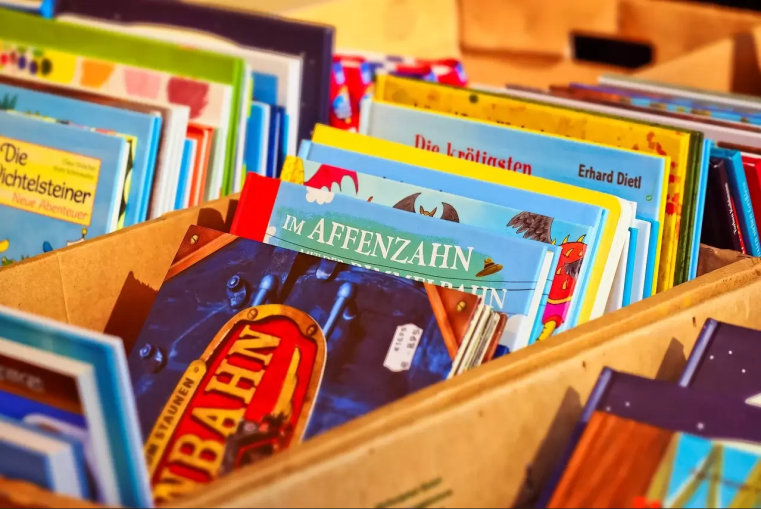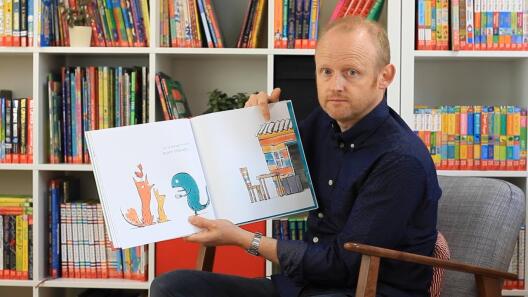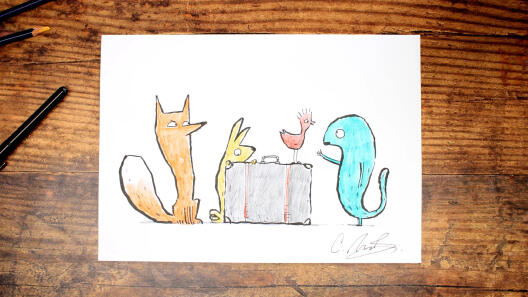Q&A with Chris Naylor-Ballesteros, author of The Suitcase
Because of our interest in the way his book mediates themes of forced migration and belonging, we reached out to the author/illustrator with a few questions, which he kindly answered for us. Check out the responses below!
What was your inspiration behind writing the book?
I was trying to follow-up my previous two books on a theme of home or shelter but in keeping with the humorous mood of those books. No story ideas seemed to work. This was the period around the Brexit referendum and Trump’s election and I was just very down about by the way that mainstream politics seemed to be (and still is) embracing the rejection of other cultures, countries and people. So I was stuck but one day doodled a small character stood at the foot of a big wall (for a failed wall story) and carrying a rucksack, and I wondered what this character was doing there, where it’d come from, where it was going and of course, what was in its bag.
When writing and illustrating The Suitcase, did you have a specific audience in mind? Whose perspectives does it reflect?
I didn’t think I could write with any authority about the stranger’s past or journey but I could more easily put myself in the shoes of those that confront the stranger. I wanted to reflect the range of emotions we have in wealthy, relatively comfortable counties to people arriving from elsewhere with nothing, in desperation and needing help. Despite all being human beings with human brains and human thoughts, some people are incredibly hostile and cynical and then there are those that feel genuine pain for others’ hardships and really want to help. I think it’s instinctive to fear or be suspicious of things that are unexpected or unknown and the important thing is to accept those feelings exist but reject them instead of embracing them.
You have said that “picture books [are] for grownups too”. Do you distinguish between audiences of ‘adults’ and ‘children’ and if so, in what ways?
In my books I hope not. Some of them are intended to be funny and have elements of slapstick humour but I really hope there’s enough there to also raise a smile (and even a laugh) for adults. I suppose a good story should have enough in it for everyone at any age. And by that I don’t mean the inclusion of adult ‘in-jokes’ intended to go over the heads of children but give the grown-ups a laugh. I don’t like it when that happens. I think there is certainly a genre of picture books with grown-up themes that younger children might find a little bit underwhelming or uneventful. I really love lots of these books but can see that they’re probably made for people like me more than for children. I hope there isn’t a stigma about adults reading picture books for themselves. There shouldn’t be.
In how far does the photograph represent a story within the larger narrative? What about the dream of the sleeping stranger?
The photo in the suitcase? Well there’s a fairly significant hidden element in that, albeit hiding in plain sight. Only one person has ever instantly spotted it and that was a five/six year old child at a school visit! I hope there might be the opportunity to revisit the Stranger’s life and what or who was in it. There’s another story in that … I was vague about the stranger’s previous life and the journey he made because they were largely irrelevant to the story of this book and would have been distractions. So the stranger’s dream was a device to show quickly that the journey he’d made was hard and perilous and not some sort of fun adventure.
Is there a reason for having nameless characters?
In such a simple story where every character appears on every page, names would be redundant and a bit of a distraction. No one refers to anyone else in a way that you’d need to specify who they’re talking about. And fictional names are a nightmare to think of, if pushed I’d have called them Fox, Bird and Rabbit for simplicity!
Is there any significance behind the choice of the fox, bird and rabbit as other characters?
Well there are some clichés that I relied upon for quickly establishing character traits, eg. foxes are sly and a bit naughty, small birds follow the flock, are twittery and perhaps gossipy. Hopefully the clichés are overturned at the end!
Does language make a difference in the way a book or story is perceived? Do you think the reception of the German and English versions of this book differ?
I’m not sure about language but think that culture and the social or political climate we’re surrounded by makes a difference to how certain ideas are received and processed. Then again, empathy is a universal trait. We all have it to different degrees and I’d hope that the fundamental theme of kindness to strangers is accepted just as easily anywhere in the world.




